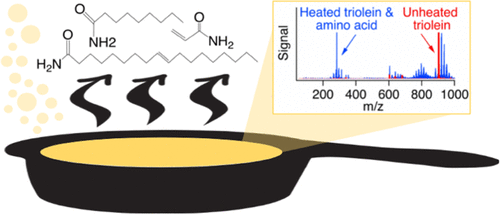当前位置:
X-MOL 学术
›
Environ. Sci. Technol.
›
论文详情
Our official English website, www.x-mol.net, welcomes your feedback! (Note: you will need to create a separate account there.)
Gas- and Particle-Phase Amide Emissions from Cooking: Mechanisms and Air Quality Impacts
Environmental Science & Technology ( IF 11.4 ) Pub Date : 2022-06-07 , DOI: 10.1021/acs.est.2c01409 Jenna C Ditto 1, 2 , Jonathan P D Abbatt 2 , Arthur W H Chan 1, 2
Environmental Science & Technology ( IF 11.4 ) Pub Date : 2022-06-07 , DOI: 10.1021/acs.est.2c01409 Jenna C Ditto 1, 2 , Jonathan P D Abbatt 2 , Arthur W H Chan 1, 2
Affiliation

|
The high-temperature cooking of protein-rich foods represents an important but poorly constrained source of nitrogen-containing gases and particles to indoor and outdoor atmospheres. For example, panfrying meat may form and emit these nitrogen-containing compounds through complex chemistry occurring between heated proteins and cooking oils. Here, we simulate this cooking process by heating amino acids together with triglycerides. We explore their interactions across different temperatures, triglyceride types, and amino acid precursors to form amide-containing products. Ammonia, arising from the thermal degradation of amino acids, may react with a triglyceride’s ester linkages, forming amides and promoting de-esterification reactions that break the triglyceride into volatilizable products. Additionally, triglycerides may thermally oxidize and fragment as they are heated, and the resulting oxygenated breakdown products may react with ammonia to form amides. We observed evidence for amide formation through both of these pathways, including gas-phase emissions of C2-11H5-23NO species, whose emission factors ranged from 33 to 813 μg total gas-phase amides per gram of amino acid precursor. Comparable quantities of particle-phase oleamide (C18H35NO) were emitted, ranging from 45 to 218 μg/g. The observed amide products had variable predicted toxicities, highlighting the importance of understanding their emissions from cooking and their ultimate inhalation exposure risks.
中文翻译:

烹饪产生的气体和颗粒相酰胺排放:机制和空气质量影响
富含蛋白质的食物的高温烹饪代表了室内和室外大气中含氮气体和颗粒的重要但限制很少的来源。例如,煎肉可能会通过加热的蛋白质和食用油之间发生的复杂化学反应形成并释放这些含氮化合物。在这里,我们通过加热氨基酸和甘油三酯来模拟这个烹饪过程。我们探索它们在不同温度、甘油三酯类型和氨基酸前体之间的相互作用,以形成含酰胺的产品。由氨基酸热降解产生的氨可能与甘油三酯的酯键反应,形成酰胺并促进将甘油三酯分解成可挥发产物的去酯化反应。此外,甘油三酯在受热时可能会发生热氧化和碎裂,产生的氧化分解产物可能与氨反应形成酰胺。我们观察到通过这两种途径形成酰胺的证据,包括 C 的气相排放2-11 H 5-23 NO 物种,其排放因子范围为每克氨基酸前体的总气相酰胺 33 至 813 μg。排放了相当数量的颗粒相油酰胺(C 18 H 35 NO),范围从 45 到 218 μg/g。观察到的酰胺产品具有可变的预测毒性,突出了了解其烹饪排放及其最终吸入暴露风险的重要性。
更新日期:2022-06-07
中文翻译:

烹饪产生的气体和颗粒相酰胺排放:机制和空气质量影响
富含蛋白质的食物的高温烹饪代表了室内和室外大气中含氮气体和颗粒的重要但限制很少的来源。例如,煎肉可能会通过加热的蛋白质和食用油之间发生的复杂化学反应形成并释放这些含氮化合物。在这里,我们通过加热氨基酸和甘油三酯来模拟这个烹饪过程。我们探索它们在不同温度、甘油三酯类型和氨基酸前体之间的相互作用,以形成含酰胺的产品。由氨基酸热降解产生的氨可能与甘油三酯的酯键反应,形成酰胺并促进将甘油三酯分解成可挥发产物的去酯化反应。此外,甘油三酯在受热时可能会发生热氧化和碎裂,产生的氧化分解产物可能与氨反应形成酰胺。我们观察到通过这两种途径形成酰胺的证据,包括 C 的气相排放2-11 H 5-23 NO 物种,其排放因子范围为每克氨基酸前体的总气相酰胺 33 至 813 μg。排放了相当数量的颗粒相油酰胺(C 18 H 35 NO),范围从 45 到 218 μg/g。观察到的酰胺产品具有可变的预测毒性,突出了了解其烹饪排放及其最终吸入暴露风险的重要性。


























 京公网安备 11010802027423号
京公网安备 11010802027423号